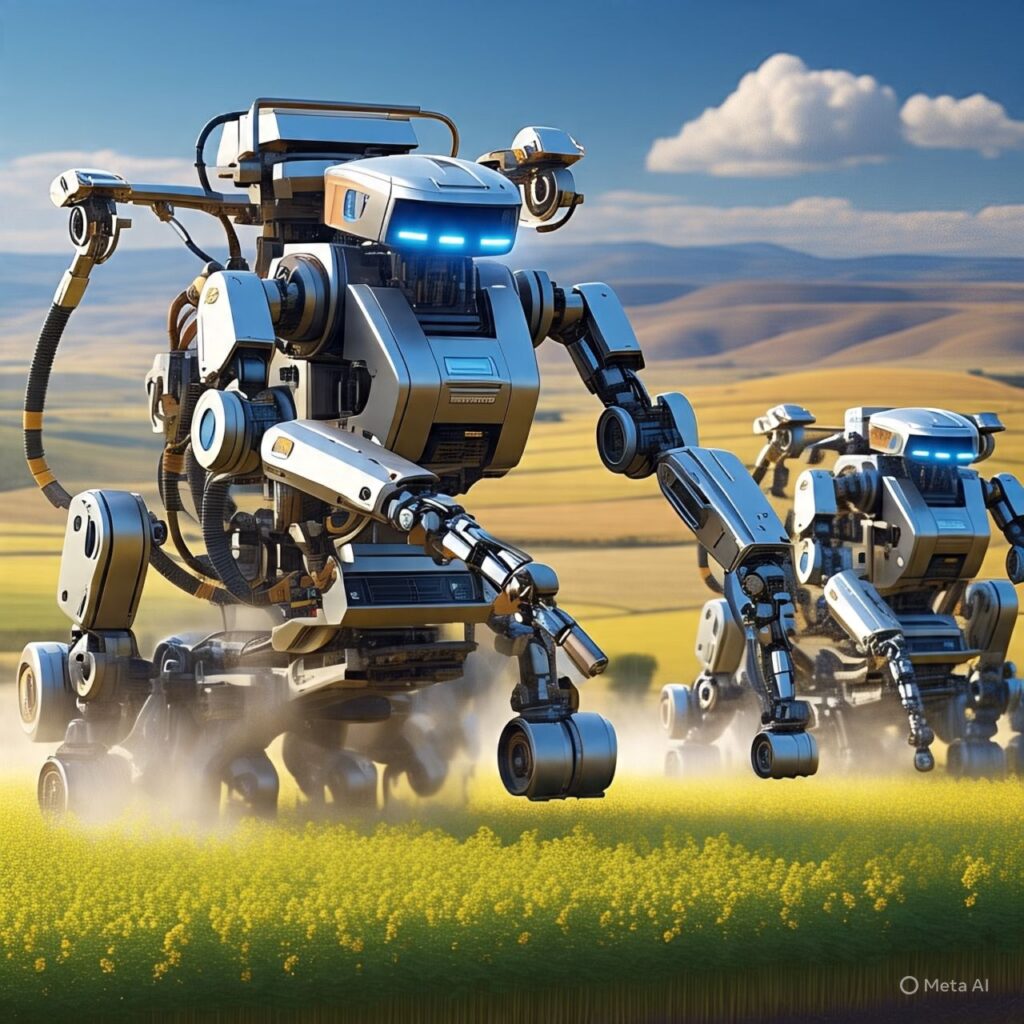The agriculture industry has witnessed tremendous transformation in recent decades. From traditional methods to smart farming, the adoption of technology has revolutionized how food is produced, monitored, and distributed. One of the most game-changing innovations to emerge is precision agriculture robotics. This powerful combination of data-driven farming and robotic technology is reshaping agriculture by making it more efficient, sustainable, and productive.
In this article, we’ll explore what precision agriculture robotics entails, how it works, the benefits and challenges, and its future potential. We’ll also answer some frequently asked questions to provide a comprehensive understanding of this rapidly growing field.
What is Precision Agriculture?
Precision agriculture refers to the use of advanced technologies to observe, measure, and respond to variability in crops and fields. Unlike traditional farming methods that apply uniform practices across large areas, precision agriculture allows farmers to customize their approach based on specific data. This method leverages:
- GPS technology
- Sensors and IoT devices
- Satellite imagery
- Drones and UAVs
- Big data analytics
By using this detailed information, farmers can make better decisions on planting, fertilizing, irrigation, pest control, and harvesting.
Introducing Robotics to Precision Agriculture
What are Precision Agriculture Robotics?
Precision agriculture robotics refers to the integration of robotic systems into precision farming practices. These robots are designed to carry out specific agricultural tasks with high levels of accuracy, consistency, and efficiency. They work in synergy with data collected from various sources (e.g., soil sensors, drones, satellite imagery) to perform operations that would otherwise require significant manual labor.
These agricultural robots are equipped with AI, machine learning algorithms, and automation systems that allow them to:
- Navigate fields autonomously
- Identify weeds, pests, and diseases
- Harvest crops at peak ripeness
- Plant seeds with precise spacing
- Apply fertilizers and pesticides in targeted areas
This robotic revolution in agriculture enables farmers to enhance productivity while minimizing environmental impact and resource usage.
Types of Precision Agriculture Robots
1. Autonomous Tractors
Autonomous tractors are self-driving machines equipped with GPS, LiDAR, and computer vision. They can plow, seed, and cultivate fields without human intervention, offering high precision and reducing labor dependency.
2. Harvesting Robots
These robots are designed to pick fruits and vegetables with speed and precision. Using AI and image recognition, they can identify ripe produce and harvest it without damaging surrounding crops.
3. Weeding and Spraying Robots
Precision agriculture robotics includes machines that can detect weeds using computer vision and eliminate them either mechanically or through targeted herbicide application. This reduces chemical usage and preserves beneficial plants.
4. Seeding and Planting Robots
Seed-planting robots are programmed to place seeds at optimal depths and spacing, improving germination rates and maximizing yields.
5. Monitoring and Surveillance Drones
While not strictly robots in the traditional sense, drones play a vital role in precision agriculture. They gather real-time data about plant health, soil moisture, and pest activity, which is used to inform robotic decision-making.
Benefits of Precision Agriculture Robotics
Increased Productivity
Robots work tirelessly and with incredible precision. They can operate 24/7, completing tasks faster and more consistently than human laborers.
Reduced Labor Costs
One of the biggest challenges facing modern agriculture is labor shortage. Robotics provides a scalable solution, particularly for tasks like harvesting, weeding, and spraying.
Better Resource Management
Precision agriculture robotics enables farmers to use water, fertilizers, and pesticides more efficiently, which conserves resources and reduces environmental impact.
Improved Crop Yields
By tailoring inputs based on real-time data and executing tasks with surgical precision, robotics can lead to healthier crops and higher yields.
Sustainability and Environmental Benefits
Targeted spraying reduces chemical runoff, while optimized irrigation systems lower water consumption. These advances make farming more sustainable and eco-friendly.
Challenges Facing Precision Agriculture Robotics
High Initial Costs
The cost of developing and deploying robotic systems can be prohibitive, especially for small to mid-sized farms. However, prices are gradually declining with technological advancement and increased competition.
Technical Complexity
Precision agriculture robotics requires integration with GPS, AI, machine learning, and sensor data, which can be challenging to manage without proper training or technical support.
Connectivity and Infrastructure
Many rural areas still lack the necessary internet infrastructure to support IoT and data-driven systems, limiting the adoption of advanced robotics.
Data Security and Privacy
With increased reliance on data collection and cloud-based systems, farmers must be mindful of cybersecurity risks and data ownership issues.

Real-World Applications and Case Studies
Case Study 1: Blue River Technology
Owned by John Deere, Blue River Technology has developed a robot that uses computer vision and AI to identify and spray herbicide only on unwanted plants. This precision approach has dramatically reduced chemical usage.
Case Study 2: Agrobot
Agrobot has created an advanced robotic strawberry picker that uses 3D imaging to assess ripeness before delicately harvesting the fruit. This innovation helps meet high labor demands during peak harvest seasons.
Case Study 3: Naïo Technologies
This French company specializes in robotic weeders like the Oz and Dino, which autonomously navigate between rows of crops to remove weeds without harming the plants.
The Role of AI in Precision Agriculture Robotics
Artificial Intelligence is the brain behind modern agricultural robots. AI enables:
- Image recognition for identifying pests, diseases, and crop maturity
- Predictive analytics for optimizing irrigation and fertilization
- Autonomous navigation through GPS and LiDAR data
- Decision-making algorithms for adjusting farming practices in real-time
As AI continues to evolve, its integration with robotics will further enhance the capabilities of precision agriculture.
Future Trends in Precision Agriculture Robotics
Integration with 5G and IoT
The adoption of 5G networks will enhance real-time communication between devices, enabling faster data transfer and improved robotic responsiveness in the field.
Swarm Robotics
This concept involves multiple small robots working collaboratively, much like a swarm of bees, to perform complex tasks across large farming areas.
Solar-Powered Robots
To increase sustainability, companies are designing solar-powered robots that can operate in fields with minimal energy costs and environmental impact.
Enhanced Human-Robot Collaboration
Instead of replacing human labor entirely, future systems will promote synergy between humans and machines, increasing efficiency while preserving employment opportunities.
Frequently Asked Questions (FAQs)
What is precision agriculture robotics?
Precision agriculture robotics refers to the use of robotic systems in farming to carry out tasks such as planting, weeding, monitoring, and harvesting with high accuracy, based on data-driven insights.
How do robots improve precision agriculture?
Robots can perform repetitive and complex tasks with consistent precision, reducing human error, lowering resource consumption, and increasing productivity and crop yield.
Are agricultural robots cost-effective?
While initial investment costs can be high, long-term savings in labor, chemicals, and increased yield make agricultural robots a cost-effective solution for many farmers.
What crops benefit the most from robotic farming?
High-value crops like fruits (e.g., strawberries, apples), vegetables, and specialty crops benefit the most from robotic farming due to their labor-intensive harvesting and maintenance needs.
What skills are required to operate precision agriculture robotics?
Operators need a basic understanding of GPS systems, data analysis, and the ability to work with hardware and software interfaces. Training programs are increasingly available to bridge the skill gap.
Is precision agriculture robotics environmentally friendly?
Yes. By reducing chemical use and optimizing resource allocation, robotic farming contributes to more sustainable and eco-friendly agriculture practices.
What are the limitations of using robotics in farming?
Limitations include high costs, technical complexity, infrastructure challenges, and occasional mechanical failures. However, these issues are gradually being addressed by innovation and education.
Will robots replace farmers?
Robots are designed to assist rather than replace farmers. While they can automate many tasks, human oversight and strategic decision-making remain critical in modern farming.
Conclusion
Precision agriculture robotics is revolutionizing how the world grows its food. With the fusion of robotics, AI, and big data, farmers now have powerful tools to enhance efficiency, reduce environmental impact, and produce more with less. As technology becomes more accessible and affordable, we can expect precision agriculture robotics to become a standard part of farming operations around the globe.
From autonomous tractors to fruit-picking machines, this evolving field offers exciting opportunities and solutions to some of agriculture’s most pressing challenges. As we look to the future, the integration of advanced robotics with sustainable farming practices will play a pivotal role in feeding a growing global population.



